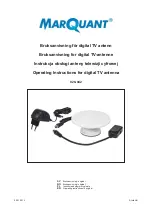11
• Amplified indoor aerial
• Dimensions and weight (aerial only):
200 x 100 x 24 mm, 150 g
• Power supply:
Power in [C]: 5Vdc/100mA
Aerial in [A]: 5Vdc/50mA
• Reception of digital terrestrial TV (DVB-T/DVB-T2) signals and DAB+ digital radio signals.
• Reception range: VHF-band III (174~230 MHz) and UHF (470~694 MHz).
• Anti-interference filters for FM, 5G, 4G and GSM.
• MMIC noise amplifier figure: = 1 dB
• Gain: VHF-III 18dB min, UHF 18.5 dB min
• Consumption: < 2 W
• Output impedance: 75 Ohm
• Temperature of use: 5~40 °C, humidity <85% (without condensation)
D
SPECIFICATIONS AND TECHNICAL DATA
The symbol of the crossed-out rubbish bin displayed on the device indicates that, at the end of its useful life, the product must be
collected separately from other waste. The user must, therefore, take the device, at the end of its useful life, to suitable differentiated
electrical and electronic waste collection centres or return it to the retailer when buying a new device of an equivalent type. The
appropriate differentiated collection will ensure that discarded equipment can subsequently be recycled, treated and disposed of in an
environmentally-compatible way. This will help prevent any possible negative effects on the environment and health and will facilitate the
recycling of the materials of which the device is composed.
TWO-YEAR WARRANTY
- The warranty lapses if the product is tampered with or used impro-
perly. Retain the purchase receipt for any claims on the warranty.
Simplified declaration of EU conformity
The manufacturer, Meliconi SpA, declares that the "AD PROFESSIONAL R1 USB amplified
aerial" type of radio equipment is in compliance with the following Directives:
- 2014/53/EU (RED)
- Directive 2011/65/EU + Delegated Directive 2015/863 (RoHS)
The full text of the Declaration of EU Conformity is available at the following Internet address:
www.meliconi.com/doc/adprofessionalr1
Remember that the use of an indoor aerial should always be considered to be an "alternative"
solution for the reception of television channels; therefore, due to the intensity of the signals
that reach the aerial inside the room, it is possible to obtain more or less satisfactory results,
depending on the conditions of use. The best results are obtained when the aerial is positioned
close to the window, in the direction of the broadcasting station, without obstacles or buildings
in between.


















